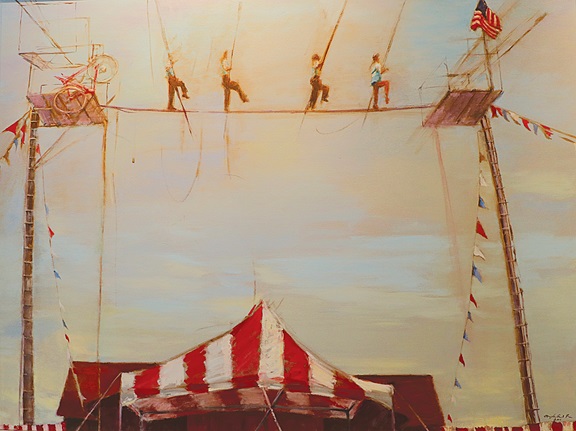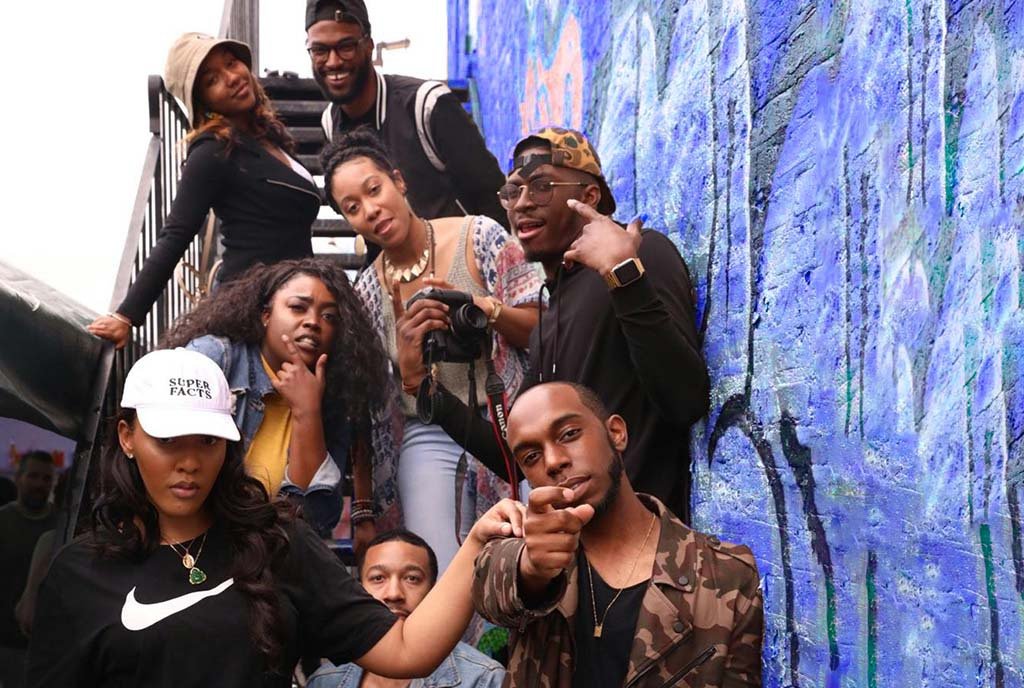
This article is from the Nonprofit Quarterly’s winter 2015 edition, “When the Show Must Go On: Nonprofits & Adversity.”
There is ample evidence to demonstrate that nonprofit arts and culture organizations in the United States are rebounding from the Great Recession—albeit more slowly than other parts of the nonprofit sector. The 2014 National Arts Index compiled by Americans for the Arts notes that while the overall economic recovery began in 2009, it did not positively affect the arts until 2012.1 A report from the Urban Institute in 2014 showed that more arts, culture, and humanities nonprofits took the largest hit—proportionately—on revenue during the recession, and also had the largest decrease in total numbers of organizations of any of the subsectors studied.2 Two more-recent reports—one from the Nonprofit Finance Fund (NFF), based on a 2015 nationwide survey of 906 nonprofit arts leaders, the other from the Greater Philadelphia Cultural Alliance, based on data from 5,502 cultural nonprofit organizations in eleven metropolitan areas—highlight some positive trends, as well as continued areas of concern, for the cultural sector.3
Our purpose here is to consider preexisting conditions that made the arts sector particularly vulnerable to the recession, as well as to evaluate actions taken by arts leaders—first to stabilize their organizations, then to experiment with new approaches to delivering their missions. We will begin with three structural weaknesses of the sector that were present, though perhaps not fully understood, before the economy collapsed—the recession exacerbated each of these underlying problems, and in some ways created a sense of urgency around them. We will discuss ways the community has responded to the postrecession landscape. We will end with lingering questions about the future of artmaking organizations.
Structural Weaknesses
Three significant areas of weakness were already at play in the nonprofit arts sector before 2008: (1) arts organizations generally were undercapitalized, with only modest liquid assets available to cover unexpected costs or see them through a rainy day (or rainy five years); (2) audiences and traditional audience behaviors were changing in important ways; and (3) employment practices at both the smallest and the largest cultural institutions were showing signs of strain.
Undercapitalization
For decades, many nonprofit arts organizations operated with zero-based budgets, aiming to break even at the end of each fiscal year. In fact, philanthropic support often hinged on break-even budgeting, and nonprofit arts groups were sometimes penalized by funders if they showed operating surpluses. This dynamic began to shift in the early 2000s, as funders increasingly looked for healthy balance sheets. But many arts groups were not able to adjust their budgeting models or build up operating reserves before the economic downturn, and most did not have a “Plan B” in place. A study commissioned by The Pew Charitable Trusts, the William Penn Foundation, and leading funders of the arts in the Philadelphia region—and carried out by researchers at TDC—highlighted two key reasons why nonprofit arts groups needed to focus on capitalization:4 (1) to avoid the “distracting and debilitating” stresses of working with narrow operating margins or even deficits; and (2) to continue to allow for innovation and experimentation and provide a cushion for artistic risk taking, rather than being “one failure away from closing.” Of course, arts leaders—board and staff—ought to have been asking “what if” questions about slim operating margins all along; and no doubt some were, although they seem to have been in the minority.
By their very nature, arts organizations are entities that need to invest in new works and take chances, which means there is an ongoing need for reserve funds—both as “R&D” capital and as a cushion for the projects that don’t succeed artistically and/or financially. Many arts organizations had to learn this lesson in real time when the recession hit: some saw steep losses in investment income eroding what cushions they had; others were caught midstream in capital campaigns or real-estate investments that floundered; some simply couldn’t keep the lights on, and closed shop. And, since no one knew how long the dark days would last, even those with reserves had to guess at how much spending down was tolerable—and many guessed incorrectly.
Foundations mostly maintained their prior levels of arts funding during the early years of the recession—until investment losses caught up with their giving cycles. Still, the sector had to think differently about capitalization, and do so at a time when just breaking even was harder than ever—virtually all categories of earned and contributed income waned as the recession wore on, and cost-cutting measures meant that many arts groups learned to live with deficits, to defer facilities maintenance, or to make difficult choices that helped the balance sheets but destabilized them in other ways.
Changing Audiences
Another shift that began before the economic downturn was a decline in subscriptions for performing arts groups and in memberships or dues for other types of cultural organizations. A number of factors were at play: increasing competition from within the growing arts sector for consumers’ time and money; a consumer trend toward “à la carte” cultural experiences rather than commitment to full seasons of programming; and declining audiences for traditional arts, like classical music and opera.
Arts groups that historically had done well with subscriptions or memberships could no longer rely on a healthy infusion of up-front earned revenue to cover the costs of presenting a season of performances or year-round exhibitions, or to make payroll and maintain facilities. Newer organizations sometimes attributed the lack of subscriptions to their newness, expecting the tide to turn. The fallout created cash-flow challenges and required higher investments in marketing each performance/event in the hopes of generating single-ticket sales to make up for losses in subscriptions and memberships. And it increased pressure to generate more contributed income, even as grants and donations faltered.
Changing demographics were affecting arts organizations before the recession. For example, older and immigrant populations—among America’s fastest-growing—were presenting opportunities and challenges to arts organizations to ensure programming was relevant and accessible to a wider range of people than it may have been historically. Too many arts organizations were not as far ahead of this curve as they ought to have been—meaning that many Americans did not feel represented or welcome at arts institutions, making it easy for them to opt out of cultural experiences during the economic downturn.
Employment Practices—Two Extremes
Like other nonprofits, arts groups tend to be founded by passionate practitioners who invest their time—and often their own money—in testing a concept and then, if it works, slowly building an organization to support the mission. However, it can take a long time—and a great deal of “sweat equity” from underpaid staff and/or unpaid volunteers—before a dance company or an arts education program begins to cover its expenses and starts paying its workers; even when a nonprofit arts group reaches this point and grows into a larger operation, employees often do not earn a living wage, and much of the work continues to be done by volunteers. Some artists never have a steady job but instead have to cobble together a living working as a contractor on a performance/ project basis.
This problem has been well documented. As John Kreidler notes in “Leverage Lost: The Nonprofit Arts in the Post-Ford Era,” “[T]he relationship of marketplace influences has always been complicated in the arts […] by the willingness of American artists and other arts workers to accept deeply discounted compensation for their labor.”5 The authors of Forces for Good and Uncharitable note that the long-term tradeoff of low pay is a weaker organization less capable of fulfilling its potential for impact, while those who invest in developing and keeping their strongest personnel through competitive compensation packages are often rewarded with stronger organizational performance.6 Yet the model of low pay for labors of love remains a dominant one in the sector, as pressure persists from board members, donors, and others for arts organizations to be as lean as possible, keeping operational, overhead, and personnel costs low.
So, even before the economic downturn, many small to midsize arts organizations were understaffed. When the recession hit, jobs were eliminated, hours were reduced, and salaries were cut to make ends meet. Arts groups did what they could to keep making art and delivering programs, meaning that staff cuts were often in areas like marketing and development—at a time when these “overhead” functions were critical to navigating the rapidly changing external environment.
Sign up for our free newsletters
Subscribe to NPQ's newsletters to have our top stories delivered directly to your inbox.
By signing up, you agree to our privacy policy and terms of use, and to receive messages from NPQ and our partners.
At the opposite end of the spectrum—in large, well-established cultural institutions like major museums and orchestras—the changing audience behaviors cited above were already making it harder to keep up with increasing operating costs as well as compensation and benefits (including health insurance), especially where labor unions were involved. Top-tier orchestras and opera companies, in particular, struggled through ugly, sometimes protracted labor disputes and the perfect storm of declining audiences, shrinking endowments/reserves, and escalating tensions between artistic leaders and management. Walkouts, lockouts, canceled seasons, bankruptcies, and failures—some at arts organizations that might have seen themselves as “too big to fail” and some that might have happened even without the economic downturn—made headlines throughout the Great Recession.7
Creative Responses
As mentioned, the economic recovery did not begin in earnest for the nonprofit cultural community until 2012. Since most of the research on the sector reflects data from no later than the 2012 fiscal year—the latest financial statements and other indicators generally available—we cannot paint a clear picture of the state of the nonprofit arts sector at the end of 2015. We can, however, highlight key trends from the most recent reports—some encouraging, some troubling—and we can point to a number of positive ways the sector has been reinventing itself to remain a vibrant force in twenty-first-century society.
We will focus on two of the liveliest areas of innovation: (1) arts organizations are actively investing in new types of audience engagement strategies and finding ways to demonstrate their value in addressing social issues; and (2) with the continued support/prodding of funders, nonprofit arts organizations and artists are experimenting with new business models and better capitalization.
Audience Engagement Strategies
The Nonprofit Quarterly has previously covered many examples of the ways arts groups have been successfully engaging audiences. An article we first published in 2014 included a range of strategies such as earlier curtain times on weeknights, pop-up performances in public spaces, presenting work in unexpected venues, and more interactive offerings.8
Among the trends we have seen since then are the following:
- According to Americans for the Arts, “Technology is changing audience engagement and the arts delivery model.”9 There is increased use of technology in audience engagement—with wildly interactive arts experiences like those offered at the Cooper Hewitt, Smithsonian Design Museum, and the Walker Art Center, active social media outreach to promote events (including designated “tweet seats” at some performances), and simulcasts of top-tier opera, dance, and theater performances in movie houses.10 (It’s worth noting that some of these developments would have happened without the recession, and not all are viewed as “wonderful” by those making art. And, even as arts groups find new ways to track audience responses to their work and engage them in live and virtual conversations, artistic decisions cannot just be given over to the public.)11
- After scaling back on marketing during the recession, arts groups appear to be doubling down on activities intended to build and retain audiences. In the recent NFF survey, 86 percent of participating organizations said that they made meaningful investments in audience engagement during 2014, and 33 percent of those groups cited audience demand for new participatory programs. Of the organizations that invested in audience development, many saw positive results within the first year—in terms of both attendance/ticket sales and an expanding donor base.12 In his latest book, Michael M. Kaiser suggests that effective marketing—with an emphasis on institutional rather than program-specific marketing—will be a hallmark of any successful twenty-first-century arts organization.13
- Some of the most innovative work in audience engagement is being done—perhaps out of necessity—in one of the most traditional arts disciplines: opera. New works (often based on familiar American stories), surprising venues, experimental pieces, and shorter works are among the developments that led Los Angeles Times music critic Mark Swed to observe in 2014, “The art form is not standing still. It’s growing, uncontrollably, by leaps and messy bounds.”14
- Across the country, arts organizations are actively seeking to broaden their relevance, appeal, and reflection of America’s changing demographics. Arts funders are involved in this effort, too. Both Grantmakers in the Arts and the Ford Foundation have made racial equity an organizational priority, while Holly Sidford’s report Fusing Arts, Culture, and Social Change: High Impact Strategies for Philanthropy has sparked a great deal of discussion about the ways philanthropic support has affected diverse organizations and audiences in the arts sector.15 And, as the population continues to shift around them, arts organizations have sought ways to become and stay engaged in communities over time—developing partnerships with civic and social groups and adapting or expanding their programs to better meet the needs and interests of local communities.16
Artists and arts organizations are increasingly demonstrating their value in solving social problems and inviting people to experience the arts right where they live. The idea of arts in economic development and city planning has roots in urban policy that run a hundred years deep—a trend that continues today in the ever-expanding field of creative placemaking.17 Since the launch of the National Endowment for the Arts’ Our Town initiative in 2010, more than $75 million has been invested in these types of projects, and funders like The Kresge Foundation and the John S. and James L. Knight Foundation also have invested heavily in creative placemaking.18 Civic leaders—largely in urban areas but also in rural communities—have welcomed the trend, using it in some cases as an impetus to tackle long-standing issues of revitalization without displacement (i.e., avoiding gentrification). Cities are also embracing the idea of artists working within government.19 And artists and arts organizations are demonstrating their value in so many other ways—from public art projects to cross-sector collaborations to environmental advocacy—that Americans for the Arts is undertaking a three-year initiative, Transforming America’s Communities through the Arts, to demonstrate the multiple values of the arts—for example, in building a creative workforce, preventing crime, serving returning military/veterans, and advancing health and wellness.20
Experimenting with New Business Models
Like Blanche DuBois, artists have always relied on “the kindness of strangers,” and will likely continue to do so. But with the increased attention to capitalization—at least as an aspirational goal—and steep losses in both government and corporate support of the arts, many nonprofit arts organizations are learning to be more self-reliant. Some are actively pursuing capitalization strategies; some are exploring new business models that emphasize earned revenue; others are entering long-term collaborations that involve shared resources (and risks); still others are experimenting with nontraditional approaches to creating and presenting work on a project basis, without creating a 501(c)(3) or aligning with a fiscal sponsor. This last development may be unique to the arts sector, and certainly bears watching. The Knight Foundation and The Philadelphia Cultural Fund are among the funders that no longer require arts grantees to be nonprofits or jump through other hoops to demonstrate their “permanence.”
Slowly—because it takes time to change a business model, to build up operating reserves or risk capital, or to realize the benefits of a strategic alliance—these efforts are bearing fruit. The Greater Philadelphia Cultural Alliance report mentioned earlier takes a deep dive into the nonprofit arts communities of eleven metropolitan regions: the Bay Area, Boston, Chicago, Cleveland, Los Angeles, New York City, Philadelphia, Phoenix, Pittsburgh, the Twin Cities, and Washington, D.C. Collectively, the 5,502 arts groups in the study spend $13 billion annually, have 906,000 paid and volunteer positions, and serve a collective population of more than 75 million residents—or 23.7 percent of the country. In addition to validating the sector’s continued recovery from the recession, the study shows the following from 2009 to 2012, based on trend data available for 2,974 organizations, representing all markets studied except the Twin Cities:21
- Revenue was up 7 percent, net assets grew by 7.6 percent, and endowments rose 13 percent;
- Profit margins in aggregate were positive, with a surplus of 3.2 percent in the most recent fiscal year;
- Total attendance was up by 3 percent; and
- Earned income drove the sector’s recovery, increasing 25.4 percent in the three-year period, with admissions, tickets, and tuition representing the single largest source of income, earned or contributed. (The flip side of this finding is that contributed income declined, especially from government sources.)
However, it must be noted that many arts groups are still financially shaky, with more than 40 percent of the organizations discussed in the study reporting deficits in the most recent fiscal year, and 18.7 percent of those groups carrying deficits of more than 10 percent. And, the ever-so-slight growth that was seen in employment was almost entirely in part-time positions.22
Even as the cultural sector looks to generate more earned income, foundation support remains critical—particularly as arts groups experiment with their business models, explore mergers and collaborations, and, of course, continue to create innovative work. A report published by NFF in October 2015 tracks the impact of thirty-six capital grants focused on institutional capitalization made by The Kresge Foundation Arts and Culture Program between 2010 and 2012;23 while it’s too soon to realize the full impact of these investments, the authors found that “grantee organizations are largely thinking in multi-year cycles and taking great strides to plan for long-term financial health.” Some of the best practices observed include the following:24
- Budgeting for surpluses;
- Developing capital budgets based on systems-replacement plans;
- Planning to create or grow cash reserves;
- Developing policies for these reserves; and
- Asking for flexible reserves as part of capital campaigns.
Across the country, foundations are increasingly pooling funds to provide professional expertise that will allow nonprofits—and not only in the arts—to thoughtfully (and confidentially) explore long-term collaborations, shared spaces, alliances, and mergers. In addition to offering technical support, these new philanthropic entities aim to change nonprofit behaviors, making it perfectly natural to include conversations about potential long-term alliances in every strategic planning cycle. Boston’s Catalyst Fund for Nonprofits, Atlanta’s Strategic Restructuring Fund, and Philadelphia’s Nonprofit Repositioning Fund are just a few examples of this trend in practice. Cultural institutions have long resisted mergers, but there are many variations on the alliance theme, and smart ones will likely find support from funders.
Lingering Questions
It will take a few more years for the full impact of the Great Recession on the cultural sector to be understood and its lessons clearly articulated. While the dust continues to settle, important questions remain for those of us who work in and support the arts.
- Who should be a nonprofit? In 2001, a study from the RAND Corporation classified arts organizations by mission type: canon, those that focus on preserving the important works of an artistic discipline; creative, those that develop new works and train artists; and community, those where the relationship to community is critical to the artistic process and organizational product.25 As pressure to develop an ever-greater percentage of earned income continues, and scrutiny of the value of nonprofits mounts, arts organizations may increasingly wonder if the nonprofit model is still the right business structure—perhaps mission types will drive new models, along with economic factors. In the meantime, young artists and arts administrators are being taught to carefully weigh their options and not pursue nonprofit status as the default model for making art. The structural employment challenges discussed above—which remain largely unresolved, even if they are not as glaringly obvious as they were a few years ago—will certainly inform this conversation.
- Is technology a friend or a foe? It is, of course, both. Technology allows artists to make art in new ways, to share art globally, and to crowdfund projects and otherwise engage audiences/followers in ways that were unimaginable even a few years ago. Technology can also enhance live arts experiences and drive interaction and collaborative artmaking. However, technology threatens to become a barrier for many people—especially younger generations—who may miss out on live arts experiences, settling instead for virtual ones. Perhaps the biggest question relating to the arts and technology is whether the cultural sector will be able to make sense of the exponentially increasing amounts of available data—advancing information literacy in ways that will continue to drive audience engagement and better demonstrate impact.
- How many arts organizations are too many? One of the long-term effects of the recession is that arts funders have become more selective and now set the bar higher for grantees. An in-depth 2014 study by TDC raised questions about the need for “rightsizing” the cultural ecosystem in the Philadelphia area, asking if audiences and funders could sustain the ever-expanding roster of nonprofit arts organizations in the region.26 The findings suggest that well-intentioned donors (and disproportionate amounts of sweat equity) sometimes sustain arts groups that are, perhaps, no longer financially sustainable, and that those resources might be better spent on more financially viable established and emerging arts groups. This is a thorny topic, but one that must be considered—even though it comes with a great big asterisk to emphasize that a balance sheet is only one way to assess the value of an arts organization. And, while that particular report focused on one region’s cultural ecosystem, its implications have resonated across the United States. The question of what the market—any market—can and will support, is hard to dismiss; in the aftermath of the Great Recession, it’s one no arts organization can afford to ignore.
Notes
- Roland J. Kushner and Randy Cohen, National Arts Index 2014—An Annual Measure of the Vitality of Arts and Culture in the United States: 2001–2012 (Americans for the Arts, 2014).
- Brice S. McKeever and Sarah J. Pettijohn, The Nonprofit Sector in Brief 2014: Public Charities, Giving, and Volunteering (Washington, DC: Urban Institute, 2014).
- Nonprofit Finance Fund, 2015 State of the Nonprofit Sector Survey: Special Supplement: Arts & Culture Sector (New York: Nonprofit Finance Fund, 2015); Greater Philadelphia Cultural Alliance, 2015 Portfolio: Culture Across Communities (Philadelphia, PA: Greater Philadelphia Cultural Alliance, 2015).
- Susan Nelson, Allison Crump, and Juliana Koo, Getting Beyond Breakeven: A Review of Capitalization Needs and Challenges of Philadelphia-Area Arts and Culture Organizations (Boston, MA: TDC, Inc., 2009), 1.
- John Kreidler, “Leverage Lost: The Nonprofit Arts in the Post-Ford Era,” In Motion Magazine, February 16, 1996.
- Leslie R. Crutchfield and Heather McLeod Grant, Forces for Good: The Six Practices of High-Impact Nonprofits, rev. ed. (San Francisco: Jossey-Bass, 2012); and Dan Pallotta, Uncharitable: How Restraints on Nonprofits Undermine Their Potential (Lebanon, NH: University Press of New England/Tufts University Press, 2008).
- Ruth McCambridge, “Walkouts and Lockouts in U.S. Symphonies: What Do They Portend?,” Nonprofit Quarterly, October 4, 2012.
- Eileen Cunniffe, “Friday Is the New Tuesday, and Other Observations on the ‘New Normal’ in the Nonprofit Arts Sector,” Nonprofit Quarterly, January 10, 2014.
- Kushner and Cohen, National Arts Index
- Eileen Cunniffe, “At Renovated Museum, Interactivity Is the Name of the Game,” Nonprofit Quarterly, June 24, 2014; and Eileen Cunniffe, “Art Center Offers ‘Pop-up’ Conceptual Art Experiences,” Nonprofit Quarterly, June 1, 2015.
- Bettina Korek, “A Study Shows How Audiences Are Changing. But Should Data Guide Artistic Decisions?,” A. Weekly, June 11, 2014.
- Nonprofit Finance Fund, 2015 State of the Nonprofit Sector Survey, 8–9.
- Michael M. Kaiser, Curtains?: The Future of the Arts in America (Lebanon, NH: University Press of New England/Brandeis University Press, 2015), 128–32.
- Eileen Cunniffe, “American Opera, Rising,” Nonprofit Quarterly, June 30, 2014; and Eileen Cunniffe, “From Black Boxes to Random Acts of Culture: Opera Companies Find New Ways to Connect with Audiences,” Nonprofit Quarterly, October 31, 2013.
- Grantmakers in the Arts, “Outline of GIA’s Work in Equity,” Racial Equity and Social Justice, accessed October 25, 2015; Darren Walker, “Inequality can be dismantled at the root,” CNN, June 17, 2015; and Holly Sidford, Fusing Arts, Culture and Social Change: High Impact Strategies for Philanthropy (Washington, D.C.: National Committee for Responsive Philanthropy, 2011).
- Partners for Livable Communities, Culture Connects All: Rethinking Audiences in Times of Demographic Change (Washington, D.C.: Partners for Livable Communities, 2011).
- Amanda Johnson Ashley, “Beyond the Aesthetic: The Historical Pursuit of Local Arts Economic Development,” Journal of Planning History 14, no. 1 (February 2015): 38–61.
- Ann Markusen and Anne Gadwa Nicodemus, “Creative Placemaking: How to Do It Well,” Community Development Investment Review 10, no. 2 (December 2014): 35-42.
- Eileen Cunniffe, “Better than an Infographic: Actors Turn Map of City’s Cultural Assets into Performance Art,” Nonprofit Quarterly, August 14, 2015; Eileen Cunniffe, “Embedding Artists in City Planning Departments: An Intriguing Approach to Civic Engagement,” Nonprofit Quarterly, September 8, 2015; “City Artist,” Public Art Saint Paul, accessed October 25, 2015; and Kate Sweeney, “MARTA Murals Are First Stop ‘En Route’ to Neighborhood Change,” WABE 90.1 FM (Atlanta), August 20, 2015.
- “Transforming America’s Communities through the Arts,” Americans for the Arts, accessed October 25, 2015; and see Eileen Cunniffe, “Engaging in an Unlikely Manner: Artists as Environmental Stewards,” Nonprofit Quarterly, April 27, 2015; Eileen Cunniffe, “Transformation: New Life and Art Will Bloom in Abandoned Detroit House,” Nonprofit Quarterly, May 19, 2015; Eileen Cunniffe, “Bloomberg Philanthropies’ Public Art Challenge Funds 4 Projects Aimed at Urban Issues,” Nonprofit Quarterly, June 24, 2015; and Eileen Cunniffe, “Artists Pitch In to Help Heal a Fractured Baltimore,” Nonprofit Quarterly, July 13, 2015.
- Greater Philadelphia Cultural Alliance, 2015 Portfolio, 4, 5.
- Ibid., 6.
- Nonprofit Finance Fund, Funding the Extraordinary: An Evaluation of The Kresge Foundation Arts and Culture Program’s Institutional Capitalization Grantmaking (New York: Nonprofit Finance Fund, October 2015), 15.
- Ibid.
- Kevin F. McCarthy and Kimberly J. Jinnett, A New Framework for Building Participation in the Arts (Santa Monica, CA: RAND, 2001).
- Susan Nelson et al., Capitalization, Scale, and Investment: Does Growth Equal Gain? A Study of Philadelphia’s Arts and Culture Sector 2007 to 2011, (Boston, MA: TDC, Inc., 2014).













